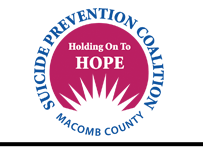 |
Warning Signs: |
Behaviors to watch for:
- Talking or joking about suicide • (“I wish I were dead.” “I can’t take it any more.” “I’ll just kill myself.” “You’ll miss me when I am gone”) Always take this seriously!
- Withdrawing • from things that they love to do.
- Giving away things • that are valuable to them.
- Isolating themselves • from family or staying away from people they enjoy spending time with.
- Drawing or writing about death. •
- Looking for or talking about ways to die.•
- Being forgetful • not being able to concentrate; not doing as well at school or work.
Feelings or moods to watch for:
- Drastic mood changes, • easily angered or upset.
- Feeling as if they are a burden • or that people will be better off without them.
- Worrying and stressing • over everything.
- Feeling hopeless • depressed, or sad for some time.
- A sudden improvement in mood • for no apparent reason. Sometimes when a person makes a plan to die, they suddenly seem to feel better, perhaps because they see an end to their pain.
Painful life events that can increase the risk of suicide:
- Being bullied • at school, by text, phone, or social media (Facebook or Twitter).
- Suffering a trauma • (injury or medical problem, sexual abuse/assault, victim of violence, legal problems).
- Questioning sexual orientation • or being labeled gay, lesbian, bi-sexual or transgendered.
- A recent loss • (moving, changing schools, parents’ divorce, relationship breakup, death of someone they love – even a celebrity).
|
|
Risk Factors: |
Painful life events that can increase the risk of suicide:
- Depression, anxiety, schizophrenia and other mental health issues.
- Drug and alcohol problems.
- Impulsiveness and aggressiveness.
- Parental psychopathology.
- No sense of purpose in life.
- Being bullied (school, text, phone, or social media).
- Recent losses or setbacks (moving, changing school, job loss or change, medical condition, relationship breakup, parental divorce, death of someone they love –even a celebrity).
- Questioning sexual orientation or being labeled gay, lesbian, bi-sexual, or transgendered).
- History of trauma or abuse (injury or medical problem, sexual abuse/assault, victim of violence, legal problems).
Other the risk factors include:
- Feeling as if they are a burden or that people will be better off without them.
- Previous attempts
- Anorexia
- Withdrawal from family, close friends, activities they loved
- Easy access to lethal means.
- Worrying and stressing over everything.
- Talking or joking about suicide.
- Giving away possessions.
- Drawing or writing about death.
- Feeling hopeless…probably the most common theme.
- Looking for or talking about ways to die.
|
|
Protective Factors: |
A protective factor is a characteristic or attribute that reduces the likelihood of attempting or completing suicide. Protective factors are skills, strengths, or resources that help people deal more effectively with stressful events. They enhance resilience and help to counterbalance risk factors. Protective factors can be considered to be either personal or external/ environmental.
Protective Factors:
- Attitudes, values, and norms prohibiting suicide e.g. strong beliefs about the meaning and value of life
- Social skills e.g. decision-making, problem-solving, and anger management
- Good health and access to mental and physical health care
- Strong connections to friends, family, and supportive significant others
- Cultural, religious or spiritual beliefs that discourage suicide
- A healthy fear of risky behaviors and pain
- Hope for the future; optimism
- Sobriety
- Medical compliance and a sense of the importance of health and wellness
- Impulse control
- Strong sense of self-worth or self-esteem
- Sense of personal control or determination
- Access to a variety of clinical interventions and support for help seeking
- Coping skills
- Resiliency
- Reasons for living
- Being married or a parent
|
External/Environmental Protective Factors:
- Strong relationships, particularly with family members
- Opportunities to participate in and contribute to school and/or community projects/activities.
- A reasonably safe and stable environment
- Restricted access to lethal means
- Responsibilities/duties to others
- Pets
|
|
Statistics: |
The scope of the problem: |
| US |
2009 |
36,909 at the rate of 12.0 per 100,000 |
| |
|
Now the tenth leading cause of death overall |
| |
|
|
| Michigan |
2009 |
1,164 at the rate of 11.7 per 100,000 |
| |
|
|
| Macomb County |
|
|
| |
2005 |
72 at the rate of 8.6 per 100,000 |
| |
2006 |
81 at the rate of 9.7 per 100,000 |
| |
2007 |
104 at the rate of 12.5 per 100,000 |
| |
2008 |
109 at the rate of 13.1 per 100,000 |
| |
2009 |
111 at the rate of 13.3 per 100,000 |
|
What it really means:
Every 15 minutes someone in the US dies by suicide, that’s 101 people per day.
Every 2 hours a youth under the age of 25 in the US dies by suicide.
Every 30 seconds an adult in the US attempts suicide.
Why do people take their lives?
People who feel suicidal are typically facing more than one problem. As outlined in the Risk Factors.
Not just why……..but when
Among people who nearly died in a suicide attempt, 24% said less than 5 minutes elapsed between deciding on suicide and making the attempt.
Another 47% said under an hour.
…………….and how
Most people who have attempted suicide have considered it for some time; they typically face multiple problems—some long term, some short term.
However, the moments when they take action are often during a brief period of heightened vulnerability.
One of the most powerful risk factors for suicide deaths is the ready availability of highly lethal methods. In the U.S., that means guns. 51% of all suicides in the US are completed with a firearm. If a person attempts with pills or poisonings they are 40 times more likely to survive the attempt than if they had used a gun. Even hangings/suffocation have twice the survival rate of those involving guns.
We now understand that how a person attempts suicide can play a critical role in whether they live…or die.
Sources:
http://www.samhsa.gov/newsroom/advisories/090917suicide0907.aspx
http://www.mdch.state.mi.us/pha/osr/CHI/Deaths/frame.asp
http://www.suicidology.org/c/document_library/get_file?folderId=232&name=DLFE-232
http://www.hsph.harvard.edu/means-matter/
Information was adapted from origional sources:
http://www.wmich.edu/counseling/prevention/protective.php
Center for Disease Control and Prevention.
Suicide Prevention Scientific Information:
Risk and Protective Factors. Retrieved on August 2, 2010 from http://www.cdc.gov/ncipc/dvp/suicide/Suicide-risk-p-factors.htm
Suicide Prevention Resource Center. Risk and Protective Factors for Suicide. Retrieved on August 2, 2010 from http://www.sprc.org/library/srisk.pdf |
|
| |
| |
|
  

586-307-9100
800-273-TALK (8255) |









